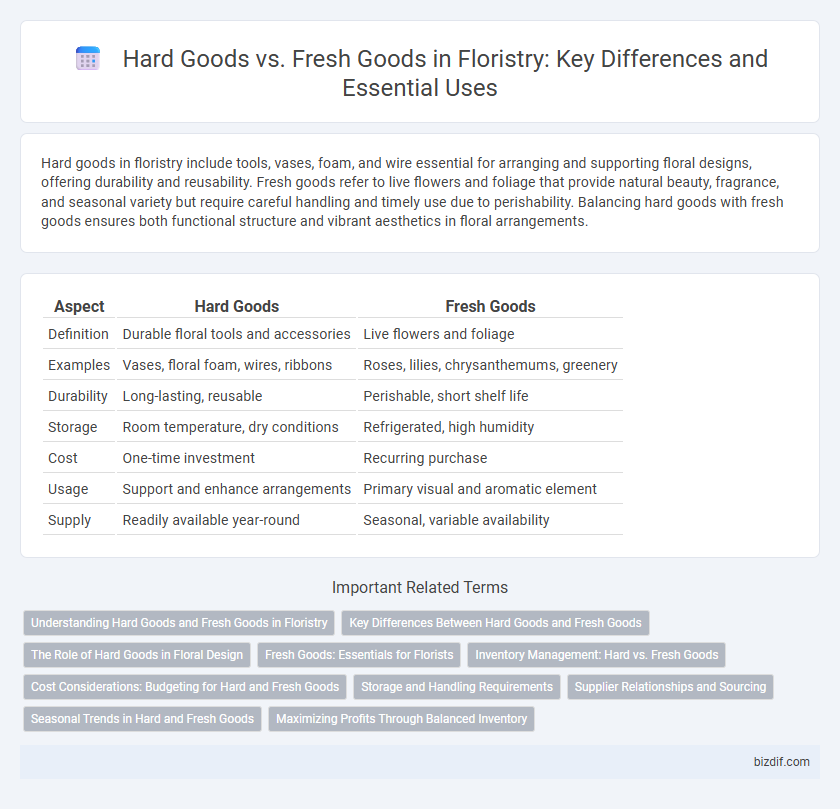Hard goods in floristry include tools, vases, foam, and wire essential for arranging and supporting floral designs, offering durability and reusability. Fresh goods refer to live flowers and foliage that provide natural beauty, fragrance, and seasonal variety but require careful handling and timely use due to perishability. Balancing hard goods with fresh goods ensures both functional structure and vibrant aesthetics in floral arrangements.
Table of Comparison
| Aspect | Hard Goods | Fresh Goods |
|---|---|---|
| Definition | Durable floral tools and accessories | Live flowers and foliage |
| Examples | Vases, floral foam, wires, ribbons | Roses, lilies, chrysanthemums, greenery |
| Durability | Long-lasting, reusable | Perishable, short shelf life |
| Storage | Room temperature, dry conditions | Refrigerated, high humidity |
| Cost | One-time investment | Recurring purchase |
| Usage | Support and enhance arrangements | Primary visual and aromatic element |
| Supply | Readily available year-round | Seasonal, variable availability |
Understanding Hard Goods and Fresh Goods in Floristry
Hard goods in floristry refer to non-living materials such as vases, floral foam, ribbons, and wires that support and enhance flower arrangements. Fresh goods encompass living plant materials like cut flowers, foliage, and greenery that provide color, texture, and fragrance to floral designs. Mastery of both hard goods and fresh goods is essential for florists to create durable, aesthetically pleasing arrangements and meet diverse customer needs.
Key Differences Between Hard Goods and Fresh Goods
Hard goods in floristry refer to non-perishable items such as floral foam, vases, ribbons, and wire, which provide structural support and decorative enhancements. Fresh goods encompass live plant materials like flowers, foliage, and greenery that have a limited shelf life and require specific care for longevity. Key differences include durability, usage purpose, perishability, and storage conditions, with hard goods being reusable and stable, whereas fresh goods need controlled environments for freshness and timely consumption.
The Role of Hard Goods in Floral Design
Hard goods in floral design include tools, containers, floral foam, and wires essential for creating and supporting arrangements, providing structure and durability that fresh goods alone cannot offer. These items enhance the longevity and presentation of floral displays by securing stems and allowing for intricate designs that maintain form over time. Integrating hard goods effectively maximizes the visual impact and functional stability of fresh flowers in both temporary and long-lasting arrangements.
Fresh Goods: Essentials for Florists
Fresh goods are the cornerstone of floristry, encompassing live flowers, foliage, and plant materials that require careful handling and precise hydration to maintain their longevity and visual appeal. Florists rely on temperature-controlled storage, regular freshness checks, and proper conditioning techniques to ensure vibrant blooms that meet customer expectations. Mastery of fresh goods management directly influences bouquet quality, enhances design versatility, and drives sales in the competitive floral industry.
Inventory Management: Hard vs. Fresh Goods
Inventory management in floristry requires distinct approaches for hard goods and fresh goods due to their differing shelf lives and storage needs. Hard goods such as vases, floral foam, and tools have long-term usability and require organized storage systems to prevent damage and loss. Fresh goods like flowers and foliage demand precise inventory tracking with temperature-controlled storage to minimize spoilage and waste.
Cost Considerations: Budgeting for Hard and Fresh Goods
Budgeting for hard goods in floristry typically involves higher upfront costs due to durable materials like vases, floral foam, scissors, and wire, which provide longevity and repeated use. Fresh goods, such as flowers, foliage, and greenery, require ongoing expenditure influenced by seasonal availability, perishability, and supplier pricing fluctuations. Effective cost management balances investing in reusable hard goods with the dynamic expenses of fresh goods to optimize overall profit margins and cash flow.
Storage and Handling Requirements
Hard goods in floristry, such as vases, floral foam, and tools, require dry, cool storage environments to prevent damage and maintain functionality, while fresh goods like flowers and foliage demand precise temperature control and high humidity to preserve freshness and extend vase life. Proper handling of hard goods includes careful cleaning and inventory management to avoid breakage and contamination, whereas fresh goods need gentle handling and hydration techniques to minimize bruising and dehydration. Optimized storage and handling practices for both categories are essential to ensure product quality and customer satisfaction.
Supplier Relationships and Sourcing
Hard goods in floristry, such as vases, floral foam, and tools, are typically sourced through established supplier relationships to ensure consistent quality and timely delivery. Fresh goods, including flowers and greenery, require strong partnerships with growers and wholesalers to secure optimal freshness, seasonal variety, and competitive pricing. Effective sourcing strategies involve balancing inventory turnover rates and lead times, enhancing supplier collaboration to meet customer demand with minimal waste.
Seasonal Trends in Hard and Fresh Goods
Seasonal trends in floristry significantly influence the availability and popularity of hard goods like vases, floral foam, and wire, as well as fresh goods such as tulips, chrysanthemums, and peonies. Hard goods often feature seasonal designs and materials, including autumnal-themed containers and spring-inspired floral accessories, which cater to festive occasions and holidays. Fresh goods fluctuate with the growing season, where winter months favor evergreens and berries while spring and summer highlight vibrant blooms and greenery, driving demand for complementary hard goods.
Maximizing Profits Through Balanced Inventory
Balancing hard goods and fresh goods inventory is essential for maximizing profits in floristry by minimizing waste and ensuring product availability. Hard goods, such as vases and floral foam, have longer shelf lives and steady demand, while fresh flowers require precise inventory management due to their perishability. Implementing data-driven forecasting and inventory control optimizes turnover rates, reduces spoilage costs, and enhances overall profitability.
Hard goods vs Fresh goods Infographic

 bizdif.com
bizdif.com